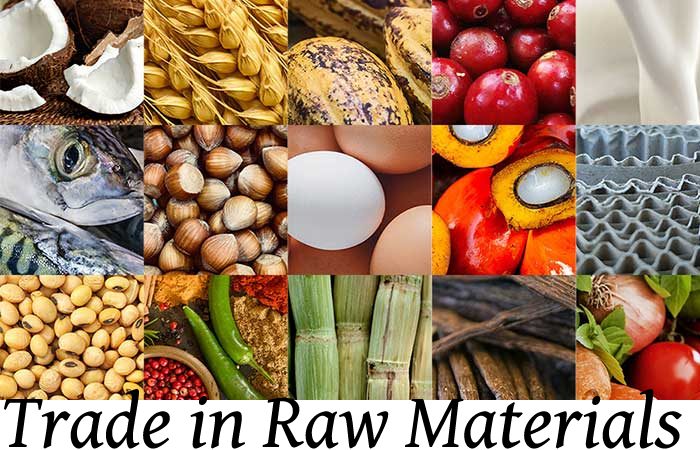Table of Contents
What Are Raw Materials?
Raw materials are used in the main construction or manufacture of goods. Commodities are things that are bought and sold on commodity exchanges around the world. Firms buy and sell raw materials in the factoring marketplace because raw materials are factors of production.
- Raw materials are inputs or inventory a business needs to make its products.
- Examples of raw materials include steel, oil, corn, grain, gasoline, lumber, forest resources, plastics, natural gas, coal, and minerals.
- Raw materials can be direct raw materials used directly in the manufacturing process, such as wood for a chair.
- Indirect raw materials are not a portion of the final product but are used integrally in production.
- The direct raw materials inventory cost is given away on the balance sheet as a current asset.
How exports of mineral commodities contribute to economy-wide growth
In some countries, Trade in Raw Materials mineral resources is an enormous source of income and prosperity. But resource abundance does not always lead to sustainable economic growth and development – it can have the opposite effect, sometimes referred to as the “resource curse.”
Countries that are worryingly dependent on their natural resources often have weaker institutions, spend less on education, and are more corrupt. The mining sector generally offers little direct employment in the countries and regions where production occurs. To create more jobs, some countries restrict exports of unprocessed minerals to encourage the creation of quality downstream processing jobs in the domestic market.
Export restrictions on raw materials are also used to achieve other goals; B. to generate income for the government, to control the export of illegally mined products. To improve environmental protection or to offset exchange rate effects through the export of several raw materials.
These are all legitimate political goals determined in each country by the preferences of its citizens.
You Can Read This Article Too: Global Value Chains and Trade
But export restrictions often do not achieve desired objectives in Trade in Raw Materials
The analysis recommends that export restrictions are not the best way to meet these crucial policy goals. And in some cases, they can have the opposite effect.
A recent study examining the application of export restrictions on various minerals and metals by four African countries with the stated aim of promoting downstream processing suggests that none of the four cases benefited downstream industries.
In some countries, the mining sector had a significantly negative effect.

The impact has been positive on world welfare and, surprisingly, even positive in countries that impose restrictions on the export of steel raw materials.
Therefore, the evidence suggests that export restrictions are not a suitable political instrument to respond to regulating the extractive sector for sustainable growth of the entire economy.
Nevertheless, export-restricting measures for many raw materials such as minerals, metals, wood, food, and agriculture.
In some emerging markets, a large proportion of mineral exports are subject to restrictions. The proliferation of such measures begs the question:
Why are policymakers using this trading tool to address national policy challenges? One reason is simply that they can.
Some regional trade agreements have tried to discipline this area. According to WTO rules, member states have to report their application of export restrictions.
But implementation has been patchy so far.
You Can Read This Article Too: Small and Medium-Sized Enterprises and Trade
Policy alternatives to export restrictions – Trade in Raw Materials
Fortunately, there are concrete examples of how natural resources can contribute to the sustainable growth of the entire economy.
Regulatory stability, especially the fiscal framework, is critical for mining companies as they need to make long-term capital investments.
The regulatory framework must be transparent and apply to all companies to reduce the potential for corrupt or pension-seeking behavior.
It is also important how the income from raw materials is spent and invested.
For example, the Botswana government has spent all of the proceeds from its vast diamond reserves over the past three decades on health, education, and infrastructure.
Some countries have successfully formed clusters around their mining sectors. In Australia, mining services – engineering, mapping, geological analysis, specialized equipment, and technologies for extraction and processing – have increased fivefold over the past 15 years and now account for 7% of Australian employment, far more than mining itself.
In other countries where illegal mining continues, civil society organizations work with small-scale miners to adapt sustainable mining practices.
Good quality and detailed geological information are key for mineral-rich countries looking to interest investment.
Such data is a public good and can improve the efficiency of exploration and mining operations.
While these are just a few examples of how some countries have successfully created stable and balanced regulatory environments.
For their industrial extractive sectors, broader policy recommendations can be referred to in the case studies of Chile, Botswana, and Peru, and Colombia.
Conclusion
Raw materials are inputs used in the construction process to create finished goods ready to sell to consumers. It makes raw materials essential to the global economy and international trade. Natural funds serving as raw materials can boost exports and help a country increase its GDP. Businesses and investors can engage in commodity trading markets through commodity exchanges.
You Can Read This Article Too: Why Are Free Markets Important? Information on Trade.
